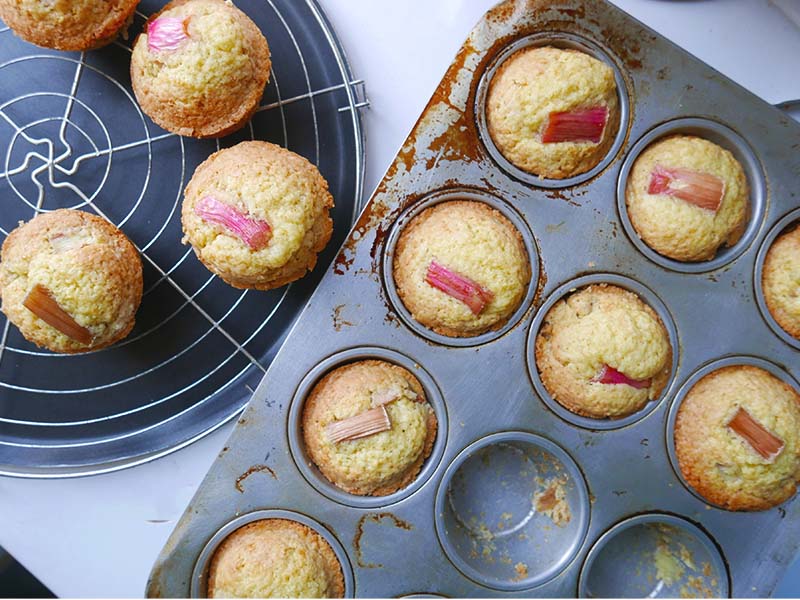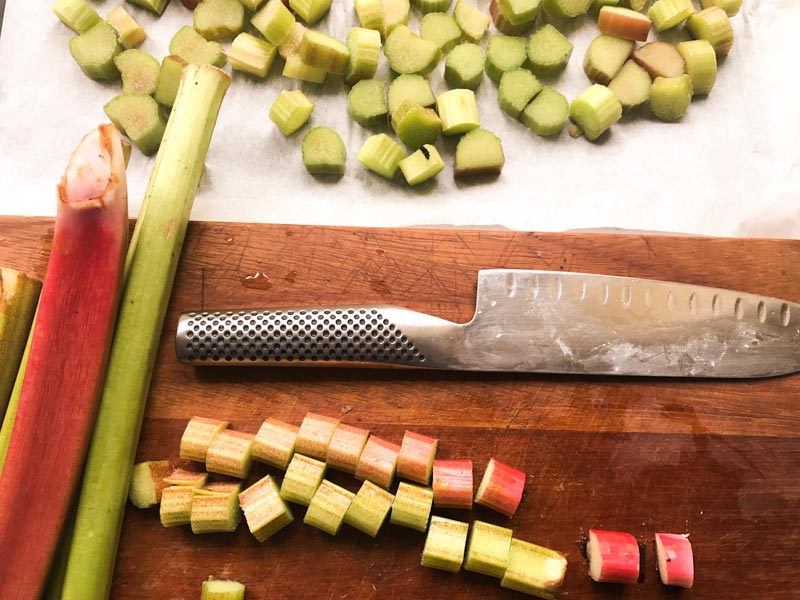The only downside to this recipe is that it requires some planning ahead; the rhubarb needs several hours of maceration to release its juices and absorb some of the sweetness of the sugar. The results make it worth it, though, and if you love rhubarb, you’ll find (and rejoice) in that taste with every bite of the muffin. If your rhubarb isn’t all really red (many stringless varieties tend more towards green), use the reddest pieces for the muffin garnishes.
Macerated Rhubarb
8 oz. rhubarb stalks
1/3 cup cane or granulated sugar
Muffins
1 2/3 (250 g) cup all-purpose flour
2/3 (150 g.) cup cane or granulated sugar
2 tsp. (10 g.) baking powder
1/2 tsp. (2 g.) baking soda
1/2 tsp. (2 g) ground ginger
1/4 tsp. (1 g.) salt
pinch freshly grated nutmeg
2/3 cup (160 ml.) buttermilk, sour cream, full-fat yogurt, or half milk, half yogurt or crème fraîche
2 eggs
2 oz. (60 g) melted butter
1- 1 1/2 cups (350 ml) fresh fruit – (cut into about 1/2-inch pieces or smaller if not using berries)
Halve the rhubarb stalks if necessary so they are no more than ½ inch (1 ½ cm) thick. Cut 12 1 ½-inch pieces from 1 stalk, and place in a bowl. Cut the remaining rhubarb into ½-inch pieces (you should have about 1½ cups), and toss with the sugar in the bowl. Macerate overnight at room temperature, stirring once or twice to help the sugar dissolve.
Preheat the oven to 350˚F, and coat a 12-muffin pan with cooking spray.
Drain the rhubarb pieces, and reserve the syrup. Set aside the 12 larger pieces.
Whisk together the flour, sugar, baking powder, baking soda,) in large bowl.
Whisk together the buttermilk (or other dairy option) and eggs in separate medium bowl.
Stir the buttermilk mixture into the flour mixture with a spatula or wooden spoon. Fold in melted butter, then the small rhubarb pieces.
Fill each muffin cup with heaping 1/2 cup muffin batter using a 1/2-cup ice cream scoop, if possible. Top each muffin with a large rhubarb piece
Bake 20 to 25 minutes, or until a toothpick or the tip of a knife inserted in the center of a muffin comes out clean, and the muffins are golden brown.
Meanwhile, boil the reserved rhubarb syrup in a small saucepan over medium heat 5 to 7 minutes, or until reduced by at least half.
Cool the muffins in the tin 5 minutes, then unmold them onto a wire rack set over a baking sheet. (You may need to run a thin metal spatula around the sides to help loosen the muffins from the pan.) Brush the muffins with the syrup, and cool completely.
((The Back Story))
Still reeling from the jacked-up rhubarb prices in the US, (FIVE DOLLARS A POUND! That’s almost as much as organic strawberries—for a perennial that grows like a weed wherever you plant it and doesn’t require meticulous, back-breaking picking.) one of the first things I bought at the farmers’ market upon my return to Cancale was a kilo of the stuff to do something with., Anything with. When you can get a produce item for one fifth of what it would have cost you a week before, it suddenly seems like a hot commodity. (That’s right. Rhubarb at the St. Malo farmers’ market goes for about a dollar a pound.)
I settled on rhubarb muffins. Since I’d never put rhubarb in muffins before, I took a peek at other websites to see what they were doing. Most of ‘em just stirred some chopped rhubarb into the muffin batter. Easy enough.
Not quite, it turns out. My first batch of rhubarb muffins were…Well, they were edible, but they weren’t amazing. The rhubarb pieces sort of melted into the batter, making it sour and rhubarb-y in places. They also released a lot of moisture, which meant the crumb around them was wet and underdone. I gave some of the muffins to my neighbors, who said they liked them, but they weren’t exactly clamoring for the recipe.
Time to think things through for myself—and try again. From my rhubarb jam-making experience, I know that macerating chopped rhubarb in sugar overnight draws out a lot of moisture. Maybe that was the key. My second batch of rhubarb muffins involved me macerating the rhubarb in sugar overnight before draining it and adding it to a muffin batter flavored with a hint of ginger and nutmeg. (Lemon zest seemed to overpower the rhubarb flavor in the first batch.) That macerated rhubarb gave off an unbelievable amount of liquid – half a cup for just a cup and a half of rhubarb—that I set aside to boil down into a glaze for the muffin tops—if the muffins themselves turned out OK.
Wonder of wonders, they did! That overnight maceration did the trick. Not only did it help keep the rhubarb pieces intact, it also sweetened them everso slightly, and somehow mellowed the sourness along the way. The syrupy glaze was just the right touch, too.
I’ll be making more muffins tomorrow. And perhaps the next day. The muffin recipe only calls for 8 ounces of rhubarb, so even after two batches of muffins, I’ve got about a pound to spare.



Leave A Comment